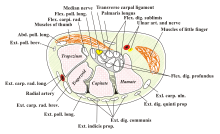User:Mr. Ibrahem/Carpal tunnel syndrome
| Mr. Ibrahem/Carpal tunnel syndrome | |
|---|---|
 | |
| Transverse section at the wrist. The median nerve is colored yellow. The carpal tunnel consists of the bones and transverse carpal ligament. | |
| Specialty | Orthopedic surgery, plastic surgery |
| Symptoms | Pain, numbness, tingling in the thumb, index, middle finger, and half of ring finger, weak grip[1][2] |
| Causes | Compression of the median nerve at the carpal tunnel[1] |
| Risk factors | Genetics, obesity, repetitive wrist work, pregnancy, rheumatoid arthritis[3][4][5] |
| Diagnostic method | Based on symptoms, specific physical tests, electrodiagnostic tests[2] |
| Prevention | Physical activity[3] |
| Treatment | Wrist splint, corticosteroid injections, surgery[3] |
| Frequency | 5–10%[6][7] |
Carpal tunnel syndrome (CTS) is a medical condition due to compression of the median nerve as it travels through the wrist at the carpal tunnel.[1] The main symptoms are pain, numbness and tingling in the thumb, index finger, middle finger and the thumb side of the ring finger.[1] Symptoms typically start gradually and during the night.[2] Pain may extend up the arm.[2] Weak grip strength may occur, and after a long period of time the muscles at the base of the thumb may waste away.[2] In more than half of cases, both hands are affected.[1]
Risk factors include obesity, repetitive wrist work, pregnancy, genetics, and rheumatoid arthritis.[3][4][5] There is tentative evidence that hypothyroidism increases the risk.[8] Diabetes mellitus is weakly associated with CTS.[3][7] The use of birth control pills does not affect the risk.[3] Types of work that are associated include computer work, work with vibrating tools and work that requires a strong grip.[3] Diagnosis is suspected based on signs, symptoms and specific physical tests and may be confirmed with electrodiagnostic tests.[2] If muscle wasting at the base of the thumb is present, the diagnosis is likely.[3]
Being physically active can decrease the risk of developing CTS.[3] Symptoms can be improved by wearing a wrist splint or with corticosteroid injections.[3] Taking NSAIDs or gabapentin does not appear to be useful.[3] Surgery to cut the transverse carpal ligament is effective with better results at a year compared to non-surgical options.[3] Further splinting after surgery is not needed.[3] Evidence does not support magnet therapy.[3]
About 5% of people in the United States have carpal tunnel syndrome.[6] It usually begins in adulthood, and women are more commonly affected than men.[2] Up to 33% of people may improve without specific treatment over approximately a year.[1] Carpal tunnel syndrome was first fully described after World War II.[9]
References[edit]
- ^ a b c d e f Burton, C; Chesterton, LS; Davenport, G (May 2014). "Diagnosing and managing carpal tunnel syndrome in primary care". The British Journal of General Practice. 64 (622): 262–3. doi:10.3399/bjgp14x679903. PMC 4001168. PMID 24771836.
- ^ a b c d e f g "Carpal Tunnel Syndrome Fact Sheet". National Institute of Neurological Disorders and Stroke. January 28, 2016. Archived from the original on 3 March 2016. Retrieved 4 March 2016.
- ^ a b c d e f g h i j k l m n American Academy of Orthopaedic Surgeons (February 29, 2016). "Management of Carpal Tunnel Syndrome Evidence-Based Clinical Practice Guideline". Archived from the original on March 30, 2020. Retrieved July 19, 2020.
{{cite journal}}: Cite journal requires|journal=(help) - ^ a b Osterman, M; Ilyas, AM; Matzon, JL (October 2012). "Carpal tunnel syndrome in pregnancy". The Orthopedic Clinics of North America. 43 (4): 515–20. doi:10.1016/j.ocl.2012.07.020. PMID 23026467.
- ^ a b Lozano-Calderón, S; Anthony, S; Ring, D (April 2008). "The quality and strength of evidence for etiology: example of carpal tunnel syndrome". The Journal of Hand Surgery. 33 (4): 525–38. doi:10.1016/j.jhsa.2008.01.004. PMID 18406957.
- ^ a b Bickel, KD (January 2010). "Carpal tunnel syndrome". The Journal of Hand Surgery. 35 (1): 147–52. doi:10.1016/j.jhsa.2009.11.003. PMID 20117319.
- ^ a b Padua, L; Coraci, D; Erra, C; Pazzaglia, C; Paolasso, I; Loreti, C; Caliandro, P; Hobson-Webb, LD (November 2016). "Carpal tunnel syndrome: clinical features, diagnosis, and management". Lancet Neurology (Review). 15 (12): 1273–84. doi:10.1016/S1474-4422(16)30231-9. PMID 27751557.
- ^ Shiri, R (December 2014). "Hypothyroidism and carpal tunnel syndrome: a meta-analysis". Muscle & Nerve. 50 (6): 879–83. doi:10.1002/mus.24453. PMID 25204641.
- ^ Amadio, Peter C. (2007). "History of carpal tunnel syndrome". In Luchetti, Riccardo; Amadio, Peter C. (eds.). Carpal Tunnel Syndrome. Berlin: Springer. pp. 3–9. ISBN 978-3-540-22387-0.
{{cite book}}:|access-date=requires|url=(help);|archive-url=requires|url=(help); External link in|chapterurl=|chapterurl=ignored (|chapter-url=suggested) (help)
